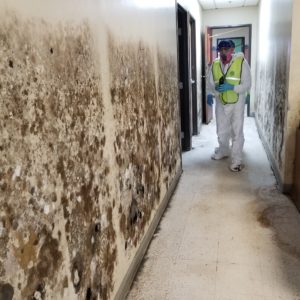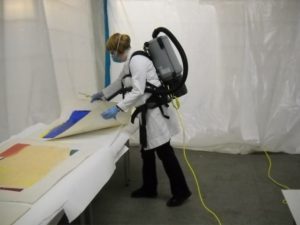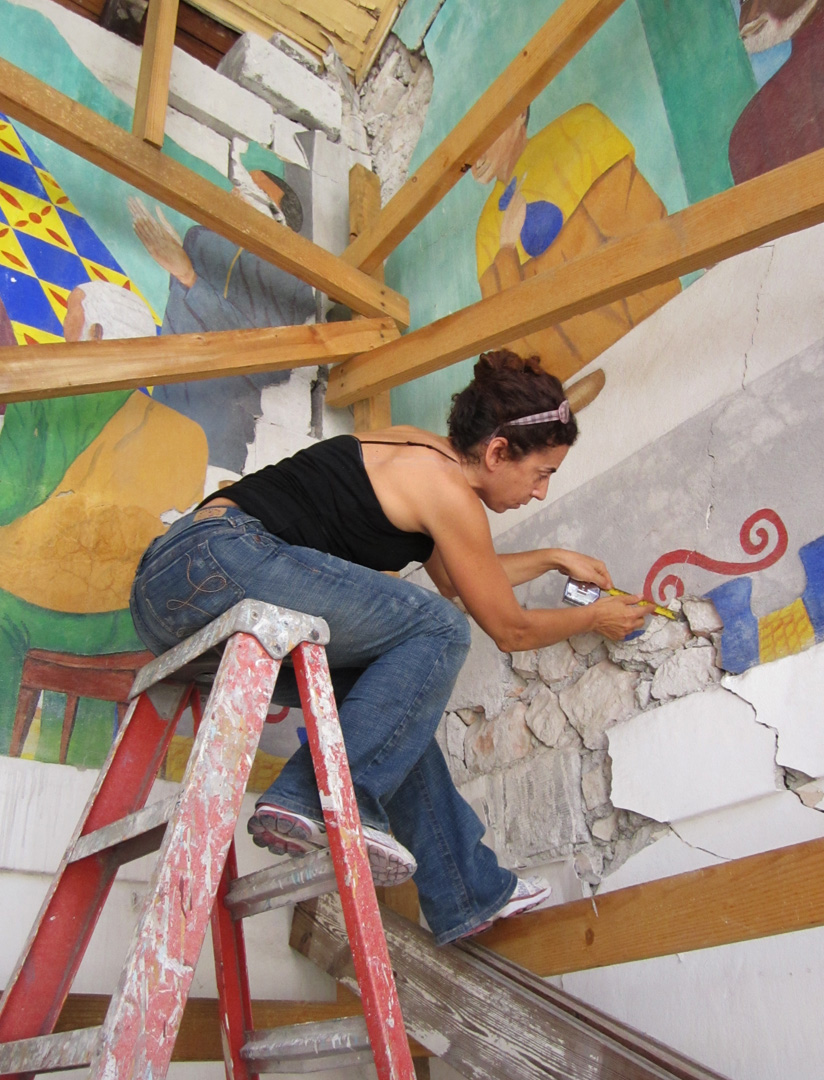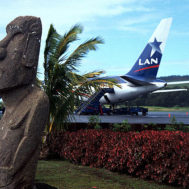The Committee for Cultural Policy spoke with Jessica Unger, Emergency Programs Coordinator for the Foundation of the American Institute for Conservation about her work and the work of the National Heritage Responders (NHR) (formerly “AIC-CERT.”)
What are the key elements of your program?
I’ll start from the beginning and how the National Heritage Responders function within the organization. I am on staff for the Foundation of the American Institute for Conservation. Our organization functions in two parts, we have a 501(c)6 organization called the American Institute for Conservation. This is a membership organization for conservation professionals. It’s called the American Institute for Conservation but we have a number of international members as well.
The Foundation of the American Institute for Conservation is a 501(c)3. Our mission is to educate conservation professionals and also to bring knowledge about the conservation profession to the broader collections care community. We run a couple of programs to educate those who might not have a conservator on staff about how to care for their objects.
So you’re also teaching general conservation efforts?
I often fall back on a general medical analogy. If you think about conservators like surgeons: highly trained, working in a specific field. For instance, a heart surgeon would be like a painting conservator, a heart surgeon is an expert on working with hearts like a paintings conservator is an expert on working with paintings.
A collections care professional is more like a general practice doctor; they’re dealing with preventive care issues. They have a more holistic view of taking care of objects.
Those who respond to collections emergencies are more like emergency medical technicians. Ideally we train a lot of our conservators to have this skill set. During emergencies, it is helpful for responders to know the specifics of how to work with different kinds of materials, but more than anything it’s helpful for them to know how to stabilize objects that have been damaged to get them ready for whatever the next phase of the recovery process might be.
Just like an EMT?

Puerto Rico, 2018. Surveying a Puerto Rican archive dealing with heavy mold growth because of power outages from Hurricanes Irma and Maria. Courtesy Foundation of the American Institute for Conservation.
Yes! We put them on the gurney, get them stabilized… What we do within our emergency programs is to make sure that this kind of response information gets to a broader audience.
We do a lot of work through our programs to try and help collecting institutions develop emergency plans. Preparedness is a big piece of the work that we do, but of course response and recovery plays a significant role. One of our signature initiatives is the National Heritage Responders (NHR) It’s a group of one hundred volunteers, who have been trained to go in after a disaster and help stabilize collections. FAIC provides support in terms of transportation and supplies, but the time that the team members spend is all volunteer.
It’s really incredible when you think about how many of these folks (who are really far along in their careers) are willing to give so much to people in need. I never cease to be amazed by that when I stop to think about it. Especially this past hurricane season, we had so many people, so heavily involved with volunteering their time.
What kinds of expertise do your volunteers have?
Between 60 – 70% of them are conservators so they would be members of the AIC but then 30-40% of them are other kinds of collection care professionals. Then there are even a few folks from the emergency professional world, people who are in security, safety, etc. who bring in that expertise.
We wanted to have a team that represented a range of disciplines and expertise but also geographic diversity. So our team members are dispersed across the country with the idea that no event would be more than a day’s drive away for a team member to be able to go and help. For instance if there was an event in a tiny museum in Wyoming, we have a team member in Cody who could go.
How did you recruit the volunteers? What did that process look like?
That was actually very easy! We have a lot of current demand for new folks to come on board too. Essentially, the idea for the team creation was born in the months after Katrina. We recognized that there was a need for a more formal structure so FAIC applied to the Institute of Museum and Library Services (IMLS) to conduct a training for responders. That first training happened in 2007: a group of around 40 to 50 individuals came on board at that point. And then pretty quickly after the training was completed, the team responded to several events.
There was Hurricane Ike in Galveston in 2008, and there was a lot of flooding in Iowa in 2008 as well. There were several events that they were pretty heavily involved with in those first years. Then we recognized that there was a need for more individuals, especially to address some of the issues of geographic diversity. So in 2011 we applied for additional funding from the IMLS to train another wave. They awarded it and we were able to train another 50-60 individuals. It was through those two waves of training that we brought the team up to 100. We’re still getting lots of requests from people who would like to come on board, and we’re addressing that now by offering some more specific regional trainings.
Last year we worked with a group in Miami and this last week I was in Houston training a team who can respond in Texas. We’re looking in this next phase to provide regional response teams with a depth of individuals who can respond in high-risk areas.
Unfortunately, the terrible irony is that we’d applied for these grants and started planning for these trainings in Miami and Houston before last hurricane season. Then the storms hit and we were worried that we were too good at picking locations for trainings. It has definitely affected most of these people that went through these programs, but in some ways it gives them some experience that they’ve grounded their training in.
You’ve had two deployments so far in Puerto Rico?
That’s right. We had one deployment in November 2017 and then we had a second deployment the week of January 8th. We had two teams on the ground for that January deployment. Basically the situation in Puerto Rico is unique and different from what a lot of other teams have experienced. The conditions aren’t stable yet. A lot of places don’t have power restored, and even those that do aren’t necessarily running their full HVAC because it puts such a strain on resources.
There’s a huge amount of mold growth and other dangerous environmental conditions that our team members are working with. So our teams were making sure that people had the appropriate personal protective equipment to be in those kinds of spaces and figuring out how to address structural issues within a building to make sure that the environment had stabilized.
The work involved was a lot of report writing because the teams wanted to provide people with a good sense of what the space was like so they could take that to FEMA, or funders, or anyone who could use that information to work on recovery efforts.
How does your triage system work?

New York, 2012. Vacuuming dried mold off of works on paper at the “Cultural Recovery Center” established in New York after Hurricane Sandy. Courtesy Foundation of the American Institute for Conservation.
There’s a great degree of flexibility in response: there can be a huge range of events, so we encourage people not to be bound by any one approach. But in general the primary thing that our responders are dealing with are wet materials.
We’ve dealt with fires, we’ve dealt with earthquakes. There’s a wide range of events that we respond to, but many events turn into wet events. If you have a fire in a museum, and you use water to put it out, you wind up with wet things. If there’s a tornado and you have a hole in your roof, you’re going to have rain on your objects. So teaching wet salvage is a primary skill set that our team members have.
There’s a lot of consideration given to the different kinds of objects that are affected. Books tend to fare well with water damage. We have processes for drying those. The biggest consideration with books is the quantity damaged. There are many professional vendors you can send large quantities of books to. Specifically you can freeze books and that arrests mold growth. Professional vendors are then able to dry them in a way that protects the material itself.
Paintings are a bit more complicated. You can’t freeze a painting, you have to slowly dry them and address any paint that flakes off. Wooden furniture you have to dry very slowly because if you dry too quickly it will crack. With a lot of composite materials, like a bone inlay piece of furniture, you have to consider that you’re working with two different processes that are happening during drying.
So basically when we train people we give them the specifics for how those different materials react and then teach them how to address different objects. This information helps shape decisions about salvage priorities.
Where does your funding come from?
The training for the NHR teams originally came from IMLS. The training we’re doing now is funded by the National Endowment for the Humanities (NEH) as well as by the Mellon Foundation. Those are kind of the big players that FAIC works with for funding programs like this.
We also try to have a reserve of money to help with deployments. We have support from Ironshore, which is a division of Lloyds of London, they provide an annual donation. We also run campaigns among our AIC members and other donors. We always try to have those resources on hand because you never know when it’s going to be an intense hurricane season, or what events we will need to respond to.
The federal agencies IMLS and NEH have always been very good at supporting our efforts. The Mellon Foundation has been as well.
How well prepared are US museums, libraries and archives for dealing with natural disasters?
That’s the million-dollar question. There was a study in 2004, The Heritage Health Index. This was a study done on institutions nationwide relating to the preservation of their collections. One of the questions asked was if the institutions had emergency plans and if they had staff trained to carry out those emergency plans. The second part is key: staff need to know how to carry out an emergency plan.
What they found across institutions was that 75-80% did not have plans with staff trained to carry them out. You have to be aware that many of the institutions in the 80% are “smaller guys” like the local historical society.
Whenever there is a huge storm looming, like before Harvey hit, people were asking me if I was worried about the Museum of Fine Arts in Houston or any of the large institutions. And honestly, I’m not, because I feel that they’re going to be able to handle these kinds of events. There could be some kind of event that affects their collections, but generally those “big guys” have their ducks in a row. It’s the “little guys” that are going to be caught unaware.
They’re the ones that are represented in that larger percentage of institutions that don’t have plans. I will say that since that report came out in 2005 there has been pretty steady progress. I would estimate that we’re looking at a much sunnier forecast from here, but I’m not entirely sure what the numbers would be. The range of large-scale events that we’ve seen over the last 10-15 years has made people aware that there is a threat and we need to do more. I think people are a bit more connected to the resources that can help them as well.
How was the response and preparedness level in Miami and Texas?

Florida, 2017. Helping to dry objects damaged at a Florida museum affected by the wind and water of Hurricane Irma. Courtesy Foundation of the American Institute for Conservation.
I was pleasantly surprised in both Texas and Florida to see how well the institutions fared. There were of course several who suffered damage, and a handful that suffered extreme damage that was heartbreaking to see, and I certainly don’t want to minimize that. But the scale of events that we saw – the amount of rain from Harvey, the intensity of Irma – I was expecting more widespread damage.
I think we’re seeing the impact of more institutions being more prepared and of course there are team members of the National Heritage Responders that have been heavily involved with working with their local communities. We also run a project called Alliance for Response, more on the preparedness end, to connect local collecting institutions with their local emergency professionals.
We have an Alliance for Response network in Texas and one in Florida, so those groups are really able to mobilize to get information out to local institutions. For example, they can remind institutions how to safely evacuate collections if they need to move things from a lower floor to an upper floor or out of the building all together. Likewise, these Alliance for Response groups can communicate updates and reports on the storm, including what to expect.
Local National Heritage Responders members often have a good sense of who had suffered the most damage after a storm and could go very quickly, conduct assessments, and then respond.
For instance, one of our team members had heard about damage at a local theater, after Harvey. The Houston theatre district is very low and the theater had taken on close to 20 feet of water. We were able to send a team of National Heritage Responders very quickly, including a furniture conservator who could help with some of their affected objects and set up a protocol for drying.
The theater had close to 100,000 props that were damaged. So having boots on the ground very quickly and the expertise in local communities – I wouldn’t be able to make the call from my office here in DC without that kind of local connection. We’re eternally grateful to the range of people across the country who are connected to their local communities and are able to provide that kind of quick response.
How long have you been involved in this work?
I’m fairly new to this field, relatively speaking. Whenever I’m speaking at conferences or on group panels with individuals that have been doing this for 15, 20 years I’m always very deferential because I’ve been in this field coming up on 4 years.
I worked in museums and in state government so cultural policy is something that interests me but I’ve always been more on the administrative side.
I think I became interested in this line of work because of one of the first exhibits I helped to curate. Three days after we opened there was a leak in the ceiling over one of the cases we’d just installed and I remember feeling like my heart had just dropped out of my chest.
I recognized just how terrifying that can be for someone, and realized that being able to be in a position where I can help people is a really rewarding experience.
What are your current priorities and what’s on the horizon?
I’ve been brainstorming for a little while now about the future of this program and what I’d like to see. I think in the fairly near future we’re going to be able to institute a new way to bring additional team members on board. The last training we had for the national team was in 2011 and I’d like to find ways to bring people who had done the regional trainings and other interested individuals onto the national team. Finding ways to expand opportunities for training is a big priority of mine.
I have another major goal to raise awareness of resources available. This is definitely one of the ongoing projects I’ve had since I started in this field. Especially with the last few hurricanes, I was surprised to see that there were people in the affected areas that really just didn’t know what was available to them.
Even if you’re not in a collecting institution: private collectors, even people with family heirlooms at home – making sure that they know about some of those basic guidelines for how to handle affected materials so that you know you can put a book in the freezer and dry it out when you have more time – that sort of awareness campaign is important to me.
Closing thoughts?
I’ll say what I often say. I’m standing on the shoulders of many others who have been plugging away at this for years. I’m just grateful to have the opportunity to help in any way that I can.
I’m constantly impressed by the generosity of our team members and their willingness to volunteer their time and expertise for this cause. I think they have made a huge impact in what we’re looking at nationwide in terms of preparedness and our ability to effectively respond and recover, but we still have a long way to go.
More information about emergency response procedures for cultural collections can be found on the AIC website on the Emergency Preparedness and Response Wiki.
 Haiti, 2010. Assessing structural damage and its impact on a wall mural following the 2010 Haitian earthquake. Courtesy Foundation of the American Institute for Conservation.
Haiti, 2010. Assessing structural damage and its impact on a wall mural following the 2010 Haitian earthquake. Courtesy Foundation of the American Institute for Conservation. 

